Fix: Thumbnails not showing in Windows 10 or 11 File Explorer
Thumbnails for images and videos not showing in Windows 10 or 11 File Explorer? Here are a few solutions you can try to fix the problem.
When you open a folder with photos or video files in Windows 10 or 11 File Explorer, you will usually see thumbnails (reduced-size versions of images or videos).
Thumbnails will appear for almost all video formats (e.g., MP4, AVI, MKV, WMV, FLV, MPG, and MOV) and image formats (e.g., JPG (JPEG), PNG, GIF, and PNG).
But, if you only see default icons (e.g., VLC icons) and no thumbnail previews, you can try the solutions on this page to fix the problem.
Windows 10
Check the “View” mode
First, you will have to make sure that the right “View” mode is selected for the folder that contains your photos or videos.
The following “View” modes show thumbnail previews for images and videos:
- Extra large icons
- Large icons
- Medium icons
- Tiles
- Content
Steps
1. Open File Explorer (Windows Explorer).

2. Open the folder that contains your pictures or video files.
3. Click on View located in the top left menu.
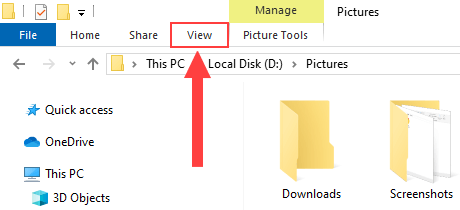
4. Click on one of the following options: Extra large icons, Large icons, Medium icons, Tiles, or Content.

Check a “Folder Options” setting
1. Open File Explorer (Windows Explorer).

2. Click on File located in the top left corner.
3. Click on Change folder and search options.
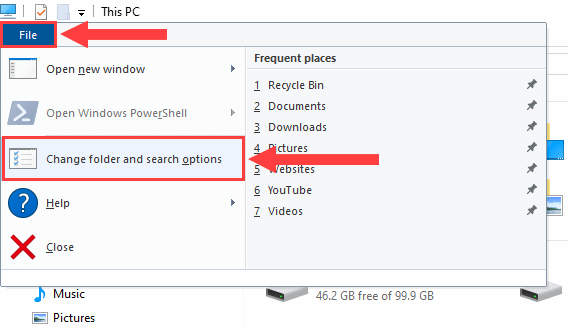
A “Folder Options” window will appear.
4. Click on View.
5. Make sure that the Always show icons, Never thumbnails option is unchecked.
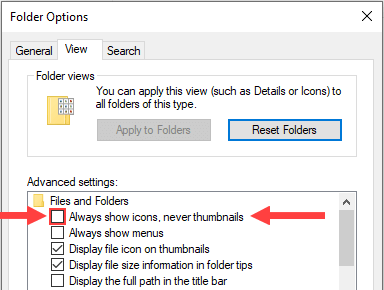
6. If the option was checked and you unchecked it, then click on the Apply button located in the bottom right corner of the “Folder Options” window.
7. Click on the OK button.
Restore File Explorer settings to default
1. Open File Explorer.

2. Click on File located at the top left.
3. Click on Change folder and search options.

A “Folder Options” window will appear.
4. Click on the Restore Defaults button.
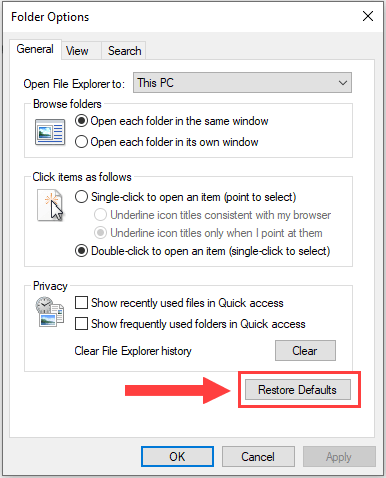
5. Click on the View tab.
6. Click on the Restore Defaults button.
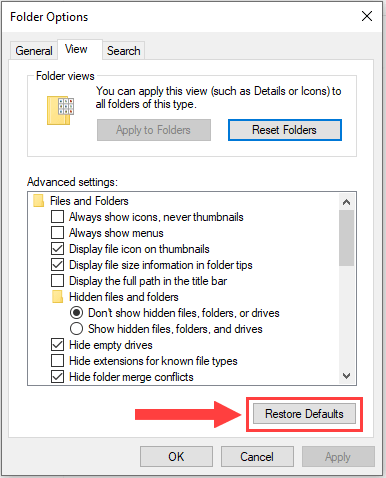
7. Click on the Apply button located below the Restore Defaults button.
8. Click on the OK button.
Clear thumbnail cache
1. Open the Windows Disk Cleanup tool.
Three ways to open the Disk Cleanup tool in Windows 10:
- Type disk cleanup into the Windows search bar and click on it when it appears.
- Press the Windows
 + R keys to open the Run dialog, type
+ R keys to open the Run dialog, type cleanmgrand then press Enter. - Click on the start menu button, scroll down and click on Windows Administrative Tools and then click on Disk Cleanup.
2. Make sure that the system drive is selected. The system drive is the drive where Windows 10 is installed.
3. Click on the OK button.
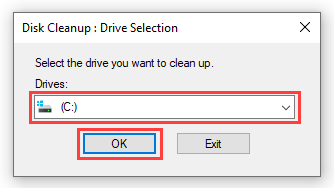
Windows will now calculate how much space you will be able to free on your system drive.
4. Make sure that the checkbox next to Thumbnails is checked (ticked).
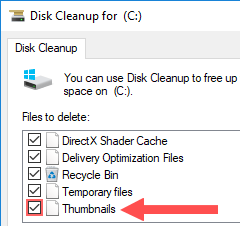
5. Click on the OK button at the bottom.
A confirmation window will appear.
6. Click on the Delete Files button.
Disk cleanup will now delete unnecessary files.
Windows will automatically generate new thumbnails when required.
Make sure there's enough space on your system drive
The following solution is from a comment on another website.
When your system drive (the drive where Windows 10 is installed) becomes full, Windows will stop generating thumbnails.
Check the disk space of your system drive (usually the (C:) drive) and when it's almost full, then delete or move things from your system drive.
When it reaches a minimum of 1 GB remaining disk space, the thumbnails probably show up again.
Restart the “Windows Explorer” process
The following solution is from a comment on another website.
1. Open Windows Task Manager.
Three ways to open Task Manager:
- Right-click on the taskbar and then click on Task Manager.
- Right-click on the start menu button and then click on Task Manager.
- Press the Ctrl + Alt + Delete (Del) keys on your keyboard and then click on Task Manager.
2. Click on More details located at the bottom left of the Windows Task Manager window.
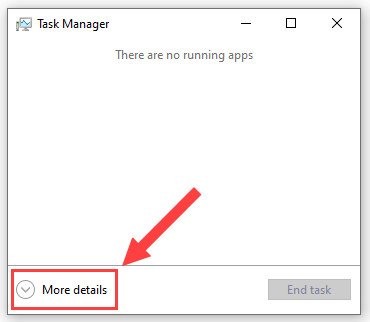
3. In the Processes tab, you right-click on Windows Explorer, and then click on Restart.
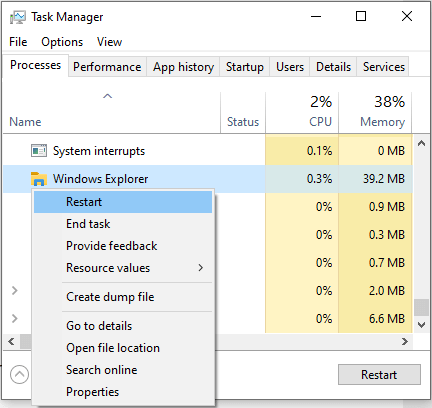
4. Close the Task Manager.
If this solution doesn't work the first time, then try it at least three times.
Windows Performance Options 1
1. Open Advanced system settings.
Three ways to open Advanced system settings:
- Press the Windows
 + Pause keys on your keyboard at the same time and then click on Advanced system settings (left side).
+ Pause keys on your keyboard at the same time and then click on Advanced system settings (left side). - Type advanced system settings in the Windows search bar and then click on View advanced system settings when it appears.
- Open Control Panel, click on System and Security, click on System, and then click on Advanced system settings (left side).
2. In the Performance section, you click on the Settings button.
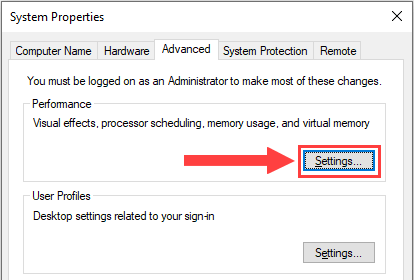
A “Performance Options” window will appear.
3. Make sure that the checkbox next to Show thumbnails instead of icons is checked.
4. Click on the Apply button located in the bottom right corner of the “Performance Options” window.
5. Click on the OK button.
Windows Performance Options 2
1. Open Advanced system settings.
Three ways to open Advanced system settings:
- Press the Windows
 + Pause keys on your keyboard at the same time and then click on Advanced system settings (left side).
+ Pause keys on your keyboard at the same time and then click on Advanced system settings (left side). - Type advanced system settings in the Windows search bar and then click on View advanced system settings when it appears.
- Open Control Panel, click on System and Security, click on System, and then click on Advanced system settings (left side).
2. In the Performance section, you click on the Settings button.

A “Performance Options” window will appear.
3. Check the checkbox next to Save taskbar thumbnail previews.
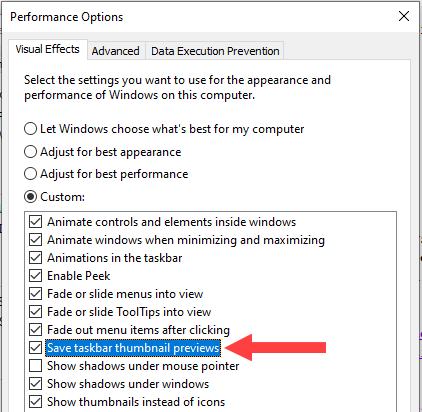
4. Click on the Apply button located in the bottom right corner of the “Performance Options” window.
5. Click on the OK button.
Use DISM and System File Checker tool
System File Checker (SFC) is a utility in Windows that allows users to scan for corruptions in Windows system files and restore corrupted files.
Steps
1. Open Windows Command Prompt as administrator.
Three Ways to open Windows Command Prompt as administrator:
- Press the Windows
 + X keys on your keyboard at the same time and then click on Command Prompt (Admin).
+ X keys on your keyboard at the same time and then click on Command Prompt (Admin). - Right-click on the start menu button and then click on Command Prompt (Admin).
- Enter cmd in the Windows search bar or Cortana, then right-click on Command Prompt and choose Run as administrator.
2. When the User Account Control (UAC) window appears, you click Yes.
Note: Depending on your settings, you might need to enter your administrator password first and then click Yes.
The Command Prompt window will appear.
3. In the Command Prompt window, you type (or copy and paste) the following command:
DISM.exe /Online /Cleanup-image /Restorehealth4. Press the Enter key on your keyboard.
Note: This process may take a few minutes to start and complete.
5. After you see a message that says “The operation completed successfully”, you type (or copy and paste) the following command:
sfc /scannow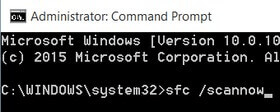
6. Press the Enter key on your keyboard.
The system file checker will scan all protected system files, and replace corrupted files with a cached copy.
This process may take a while.
7. Wait till the process is complete.
8. After you see a message that says “Verification 100% complete. Windows Resource Protection did not find any integrity violations.”, you can close the Command Prompt or Terminal window.
9. Check if the thumbnails are showing up. If it's still not working, restart your PC, and if that doesn't help, then try the next solution.
Use Icaros (Free)
Icaros is a free program that can generate thumbnails for almost all video and image file types.
You can download Icaros here.
1. Open Icaros.
2. Make sure that THUMBNAILING is activated.
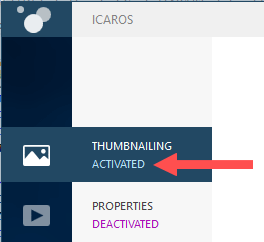
If thumbnailing is deactivated, then click on it to activate.
3. Select an option (e.g., MOST KNOWN) at THUMBNAIL FILETYPES and PRESET.
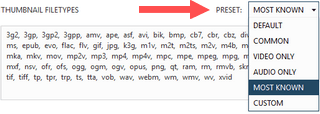
4. Close Icaros.
Windows 11
Check the “View” mode
First, you will have to make sure that the right “View” mode is selected for the folder that contains your photos or videos.
The following “View” modes show thumbnail previews for images and videos:
- Extra large icons
- Large icons
- Medium icons
- Tiles
- Content
Steps
1. Open File Explorer (Windows Explorer).

2. Open the folder that contains your pictures or video files.
3. Click on View located in the top menu.
4. Click on one of the following options: Extra large icons, Large icons, Medium icons, Tiles, or Content.
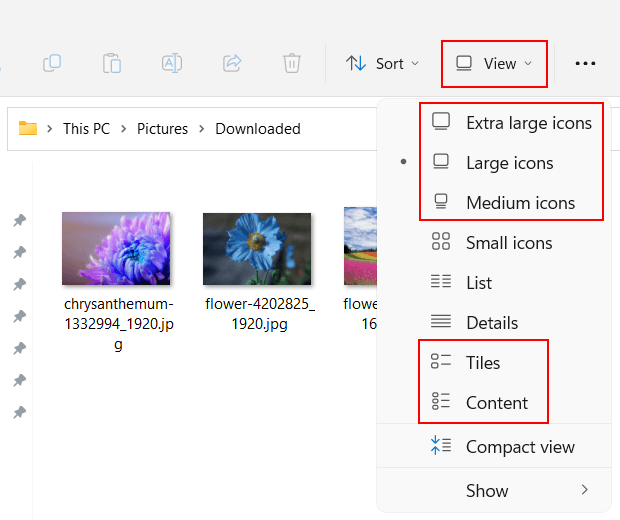
Check a “Folder Options” setting
1. Open File Explorer (Windows Explorer).

2. Click on the three-dot icon (...) located in the top menu.
3. Click on Options.
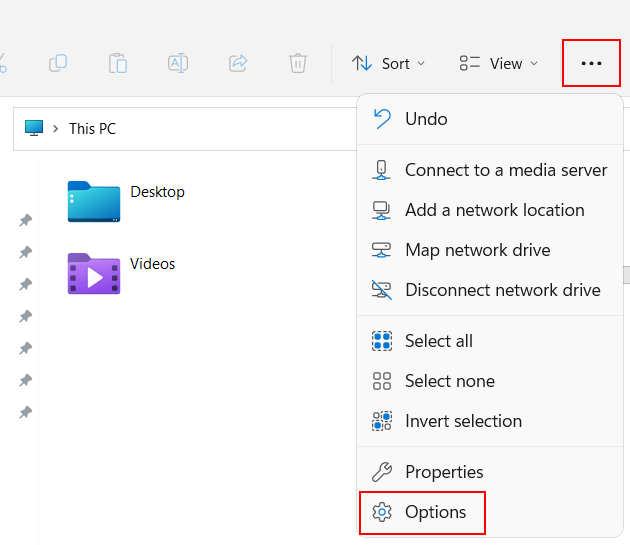
4. Click on View.
5. Make sure that the Always show icons, Never thumbnails option is unchecked.
6. If the option was checked and you unchecked it, then click on the Apply button located in the bottom right corner of the “Folder Options” window.
7. Click on the OK button.
Restore File Explorer settings to default
1. Open File Explorer (Windows Explorer).

2. Click on the three-dot icon (...) located in the top menu.
3. Click on Options.

4. Click on the Restore Defaults button.
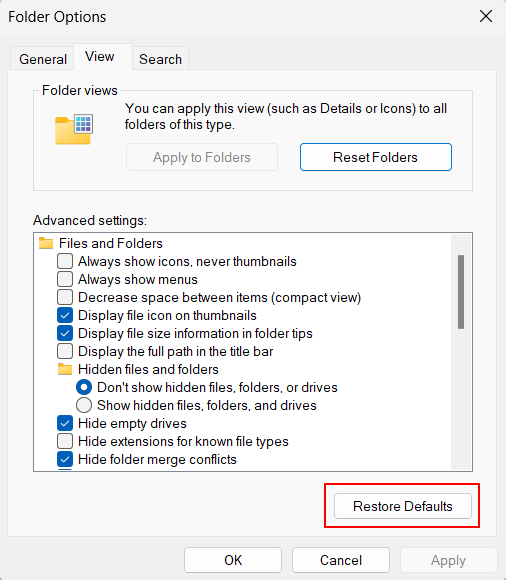
5. Click on the Apply button located below the Restore Defaults button.
6. Click on the OK button.
Clear thumbnail cache
1. Open settings by right-clicking on the Windows start menu button (or pressing the Windows ![]() + X keys) and then click on Settings.
+ X keys) and then click on Settings.
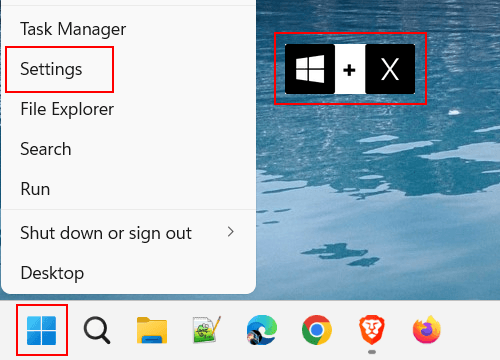
You can also open settings by pressing the Windows ![]() + I keys on your keyboard simultaneously.
+ I keys on your keyboard simultaneously.

2. In “System”, you click on Storage.
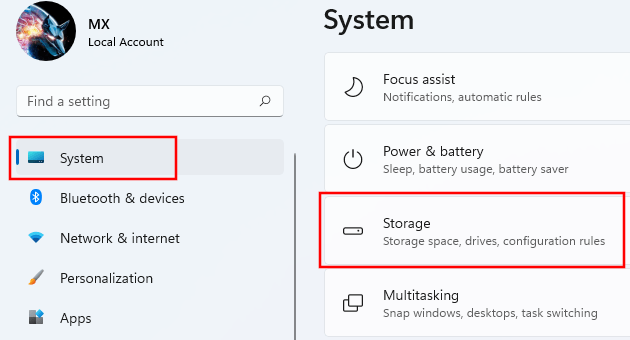
3. Click on Temporary files.
Windows will now search for temporary files that can be deleted.
4. Check the checkbox next to Thumbnails.
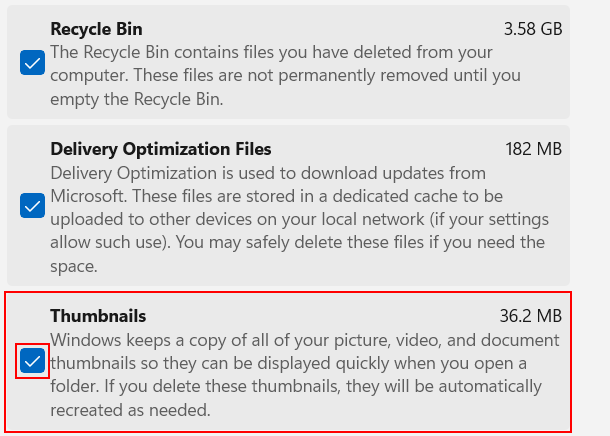
5. You can also check other files you want to delete.
6. Click on the Remove files button.
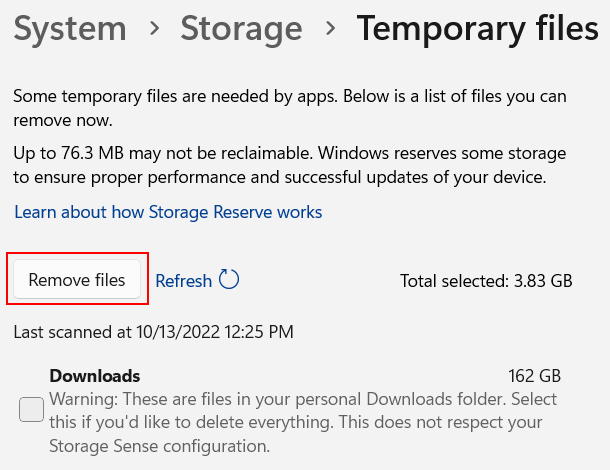
A small window will appear.
8. Click on the Continue button.
Windows will now delete thumbnails and all other selected files.
This process may take a while. It depends on which other files you've selected. And sometimes it seems like nothing is happening. But you must let the program complete the process.
Windows will automatically generate new thumbnails when required.
Make sure there's enough space on your system drive
The following solution is from a comment on another website.
When your system drive (the drive where Windows 11 is installed) becomes full, Windows will stop generating thumbnails.
Check the disk space of your system drive (usually the (C:) drive) and when it's almost full, then delete or move things from your system drive.
When it reaches a minimum of 1 GB remaining disk space, the thumbnails probably show up again.
Restart the “Windows Explorer” process
1. Open Windows Task Manager by right-clicking on the Windows start menu button (or pressing the Windows ![]() + X keys) and then click on Task Manager.
+ X keys) and then click on Task Manager.
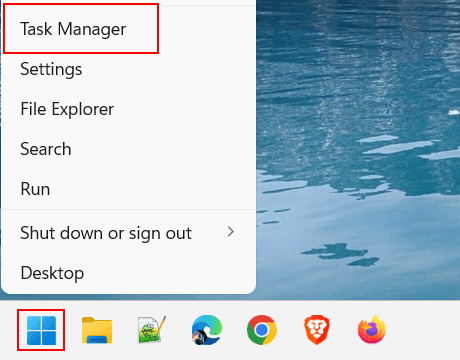
You can also open Task Manager by pressing the Ctrl + Shift + Esc (Escape) keys on your keyboard simultaneously.
2. If the “User Account Control” window appears, you click Yes.
Note: Depending on your settings, you might need to enter your administrator password first and then click Yes.
3. In the Task Manager window, you search for the Windows Explorer process.
4. Right-click on Windows Explorer process.
5. Click on Restart.
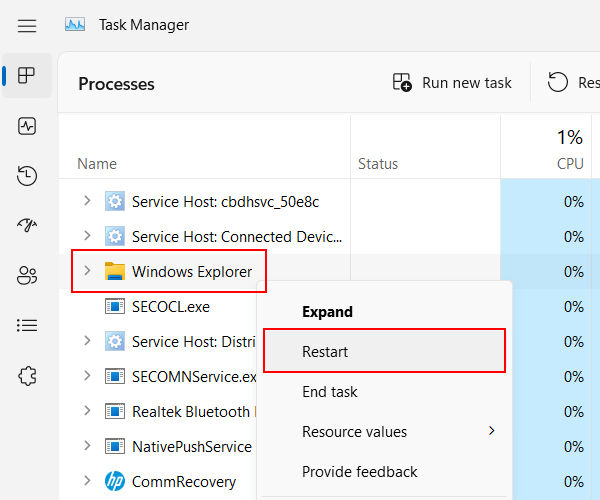
Windows 11 will restart the “Windows Explorer” process again.
6. You can now close the Task Manager window.
If this solution doesn't work the first time, then try it at least three times.
Windows Performance Options 1
1. Click on the Windows start menu button or search icon located in the taskbar.

2. Type advanced system settings.
3. Click on View advanced system settings when it appears.
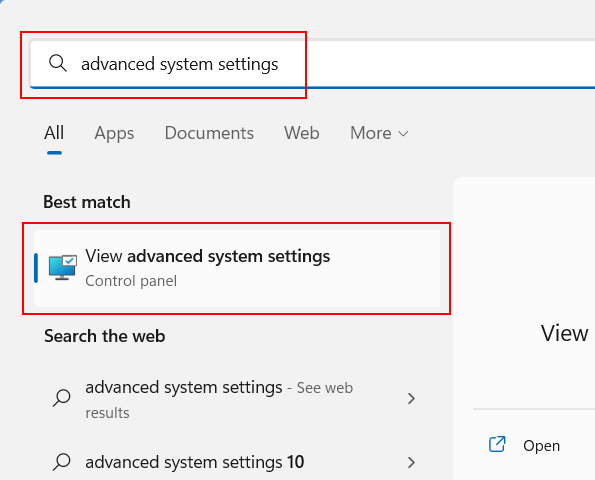
You can also find advanced system settings by right-clicking on the Windows start menu button > System > Device specifications > Advanced system settings.
4. In the Performance section, you click on the Settings button.

A “Performance Options” window will appear.
5. Make sure that the checkbox next to Show thumbnails instead of icons is checked.
6. Click on the Apply button located in the bottom right corner of the “Performance Options” window.
7. Click on the OK button.
Windows Performance Options 2
1. Click on the Windows start menu button or search icon located in the taskbar.

2. Type advanced system settings.
3. Click on View advanced system settings when it appears.

You can also find advanced system settings by right-clicking on the Windows start menu button > System > Device specifications > Advanced system settings.
4. In the Performance section, you click on the Settings button.

A “Performance Options” window will appear.
5. Check the checkbox next to Save taskbar thumbnail previews.

6. Click on the Apply button located in the bottom right corner of the “Performance Options” window.
7. Click on the OK button.
Use DISM and System File Checker tool
System File Checker (SFC) is a utility in Windows that allows users to scan for corruptions in Windows system files and restore corrupted files.
Steps
1. Open Windows “Command Prompt” or “Terminal” as an administrator. One way to do this is to right-click on the start menu button (or press the Windows ![]() + X keys) and then click on Terminal (Admin).
+ X keys) and then click on Terminal (Admin).
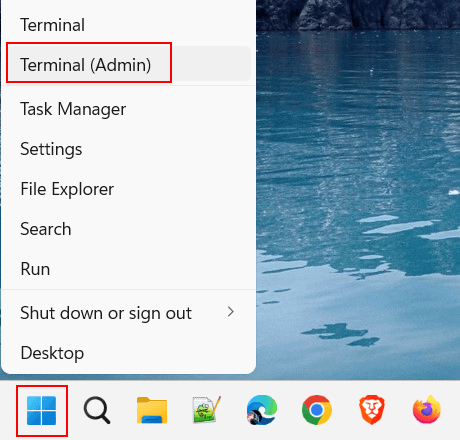
You can also click on the search icon located in the taskbar > type cmd > right-click on Command Prompt > click on Run as administrator.
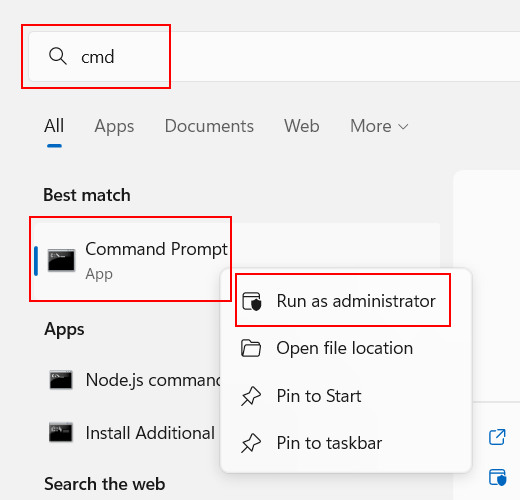
Or you press the Windows ![]() + R keys on your keyboard simultaneously to open a “Run” window > type
+ R keys on your keyboard simultaneously to open a “Run” window > type cmd into the “Run” window > press the Ctrl + Shift + Enter keys on your keyboard simultaneously.

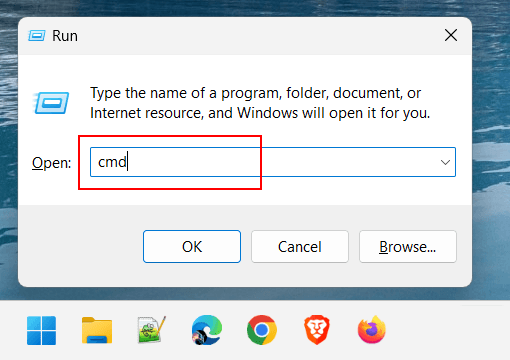
2. When the “User Account Control” window appears, you click Yes.
Note: Depending on your settings, you might need to enter your administrator password first and then click Yes.
3. In the Command Prompt or Terminal window, you type (or copy and paste) the following command:
DISM.exe /Online /Cleanup-image /Restorehealth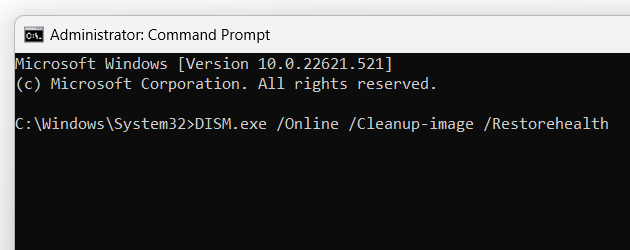
4. Press the Enter key on your keyboard.
Note: This process may take a few minutes to start and complete.
5. After you see a message that says “The operation completed successfully”, you type (or copy and paste) the following command:
sfc /scannow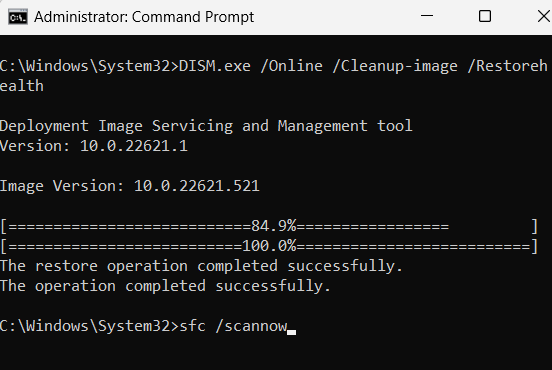
6. Press Enter on your keyboard.
The System File Checker tool will scan all protected system files, and replace corrupted files with a cached copy.
This process may take a while.
7. Wait till the process is complete.
8. After you see a message that says “Verification 100% complete. Windows Resource Protection did not find any integrity violations.”, you can close the Command Prompt or Terminal window.
9. Check if the thumbnails are showing up. If it's still not working, restart your PC, and if that doesn't help, then try the next solution.
Use Icaros (Free)
Icaros is a free program that can generate thumbnails for almost all video and image file types.
You can download Icaros here.
1. Open Icaros.
2. Make sure that THUMBNAILING is activated.

If thumbnailing is deactivated, then click on it to activate.
3. Select an option (e.g., MOST KNOWN) at THUMBNAIL FILETYPES and PRESET.

4. Close Icaros.